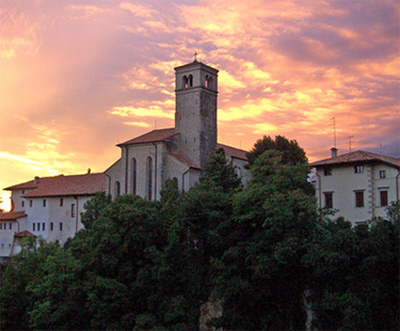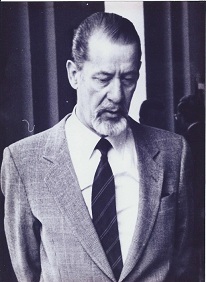Scientific Committee
Created by the Longobardia Association in 2013, the International Scientific Committee “Amelio Tagliaferri” has the preliminary and primary task of drawing up the basic Criteria of the cultural route “Longobard Ways across Europe” to be submitted for examination by the Institut Européen des Itinéraires Culturels in Luxembourg at the formal presentation of the application for inclusion in the list of European Cultural Routes recognized by the Council of Europe. The Committee interacts, as a consulting and proposing body, with the Executive Committee of the Longobardia Association.
Functions of the Scientific Committee
The Committee - made up of Italian and European expert in various disciplines - has multi-disciplinary functions. The thematic areas in which it performs consulting and proposing tasks are: history and archaeology, religious culture, economic history, social and economic development, youth activities and artistic activities.
The Committee also has the following tasks:
- drafting and proposing ventures and events referring to cultural, scientific and religious elements and to the social and economic development of the network territories;
- working towards a real and effective connection between the objectives of cultural investigation of the Longobard experience (with particular regard to the economic history of the Early Middle Ages and of the Middle Ages) and aspects of the Route concerned with promoting education and training;
- evaluating and giving indications on initiatives that can be connected to the Route, that are able to correspond to the needs expressed by the world of research for the social and economic development of the Territories.

Cividale del Friuli - Centro San Francesco sede del Comitato Scientifico
Structure of the Scientific Committee
The complex structure of the Route "Longobard Ways across Europe" has required the subdivision of the Scientific Committee into various specialized sections:
Historical-archaeological section (responsible for identifying the Criteria on the basis of which the scientific lines will be defined for the "design" of the European Route and of the Routes within the individual Clusters)
- Routes Section (organization and coordination of the thematic trails in the individual Clusters)
- Museum Section (coordination of the "network" of European Museums of interest concerning the Longobards)
- Historical-documentary Archives Section (coordination of the "network" of Institutions housing "deposits" of documents of interest concerning the Longobards)
- Ecclesiastical Heritage Section (coordination of initiatives for the particular and general promotion and enhancement of the network)
- Universities Section (coordination of European Universities collaborating with the Route)
- Youth and Artistic Activities Section (coordination of initiatives and projects)
- Social and Economic Development Section (coordination of activities and projects related to the promotion and exploitation of the endogenous resources of the Clusters for the development of tourism)
- ICT /Information and Communications Technology Section (coordination of the multimedia systems applied to the Route)
- System Monitoring Section (followed by Istituto Eurispes, Rome)
Each Section has its own expert Coordinator. Based on the Statue of the Association, the general coordination of the activities of the Sections is the task of the General Secretary of the Longobardia Association.
Amelio Tagliaferri, the forerunner

In launching the construction of the Route “Longobard Ways across Europe” for promoting the history of the Longobards as a means of cultural tourism - as requested by the founding objectives of the European Routes established by the Council of Europe - the Associazione Longobardia wished to honour the figure of a distinguished scholar who is credited with having drawn the attention of public opinion to the history and culture of the Longobards at world level: Professor Amelio Tagliaferri (1925-1994). Tagliaferri along with Gian Piero Bognetti, Carlo Guido Mor, Pier Sylverio Leicht, Otto von Hessen and, even before them, with the proto-archaeologist from Cividale, Ruggero della Torre, were, in Italy, the noble fathers of the Longobard revival on whose work were based the studies of the second half of the twentieth century and, in particular, the study on the Longobard Temple in Cividale by the Norwegian scientific group of Hans Peter L'Orange and Hjalmar Torp.
In choosing the person to whom to dedicate the Scientific Committee, the Associazione considered all the activities that Tagliaferri carried out: from teaching to scientific research, museum direction and the organization of grand events. Tagliaferri was born at Cutigliano (Pistoia) and lived between Brescia and Cividale del Friuli. He distinguished himself especially for having launched the revaluation of the Longobard presence in Italy also from an economic viewpoint, using a coordinated method of research and analysis.
At University, Tagliaferri had been a student under Amintore Fanfani, his uncle and - like the Paduan Gino Luzzatto - advocate of the importance to be attributed to the economic history of the whole period of the Middle Ages. In his academic career - spent between Verona, Venice, Trieste and Udine - Tagliaferri drafted and expressed original and significant means for supporting the full revaluation of the historic importance of the Longobard experience.
From 1980 to 1990 he was Director of the National Archaeological Museum of Cividale del Friuli where he organized the great exhibition "The Longobards - Greatness and splendour of a European people", an important milestone that enabled the general public to rediscover the old Mediaeval people.
Tagliaferri and the centrality of man
Tommaso Fanfani, Professor of History of Economics at Pisa University, recalls the figure of Amelio Tagliaferri: “He was my teacher, the man who encouraged me to study the History of Economics and who remains a precise point of reference for me, today as in the past. He loved history in the same way as his own teacher, Amintore Fanfani... that is as a theorist of the centrality of man..." Among the inspiring principles of the Longobardia Association, this precious quality of the scholar increases the value of the dedication of the International Scientific Committee to the figure of Amelio Tagliaferri.
ANNEX
News
-
2025 21 MarchERRATA CORRIGE CONVEGNO DONNE LONGOBARDE
-
2025 19 March
-
2025 19 MarchDa Salerno a Monza: convegni nel nome delle mulieres longobarde
